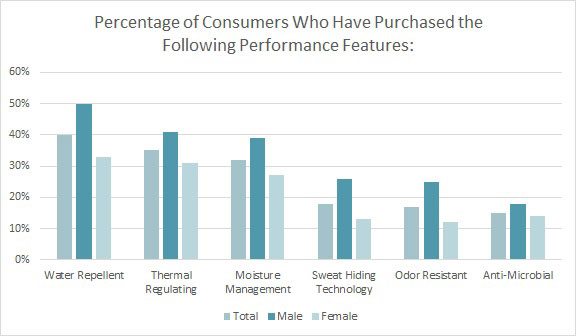For outdoor enthusiasts, exercising or partaking of activities in a natural environment goes without saying. Hiking, biking, kayaking, and so many more pursuits encompass the enjoyment of exercising while enjoying nature. But the enjoyment of all things natural often doesn’t carry over to outdoor apparel due to the prevalence of synthetics. Some companies, however, are setting out to change that.[quote]
New technologies in moisture wicking and weather resistance are helping cotton overcome outdoor challenges. Those in the active outdoor market have been wary of traditional cotton when worn for recreation such as hiking and backpacking, as sweat could be soaked up by the absorbent fabric, keeping moisture next to the skin and giving wearers a chill. But various technologies are proving performance cotton can repel wetness from the weather, as well as wick moisture from the inside and dry faster than traditional cotton and man-made fibers like polyester.
“We see a tremendous interest, and brands value the idea of adding our technology innovations to their cotton products,” says David Earley, senior director of supply chain marketing for Cotton Incorporated. “Many companies are looking at how they can integrate cotton into their line in some way.”
Opportunities exist for retailers and brands that adopt cotton outdoor product. That’s because although consumers know about active performance technologies such as water repellency, thermal regulation, and moisture management, research shows the percentage of consumers who have actually purchased them in the past is about half of the awareness level. For instance, 85 percent of men and women have heard of water repellent features, 78 percent know about thermal regulating benefits and 71 percent know about moisture management, according to the Cotton Incorporated Lifestyle Monitor™ Survey. Yet just 40 percent have purchased cotton with water repellency, 35 percent have bought clothes with thermal regulating properties, and 32 percent with moisture management.

The thing is, Monitor™ research shows consumers who’ve bought apparel with performance technologies in the past are very satisfied (80-to-95 percent) with their performance — and twice as likely as non-purchasers to pay a premium for these added benefits.
Stio, the Jackson Hole, WY-based outdoor apparel company, is one of the companies looking to capitalize on cotton performance apparel. It adopted TransDRY® moisture wicking technology for its spring ’16 line: the men’s Tensleep twill pant, and the men’s and women’s Tensleep short. The legitimate technical apparel company sees these pieces as being worn as outdoor wear, as well as everyday sportswear with a technical edge. For instance, wearers can go bouldering, brush the bottoms off, and then head to work or dinner.
“Stio chose cotton for its natural, inherent qualities of comfort and breathability, but we wanted to address its weakness of not drying quickly when wet,” says founder and president Stephen Sullivan. “So we chose TransDRY® for its lower overall absorbent capacity and ability to transfer moisture away from the body, keeping you dryer, cooler, and more comfortable.”
Earley says Stio is one of the companies out in front in expanding its product line to include tech cotton.
“Outdoor and active brands that focus a lot on synthetics for performance activities are looking at how they can incorporate branded lifestyle apparel that can be worn for everyday use,” Earley states, saying he heard such remarks when companies visited Cotton Incorporated’s booth at the recent Outdoor Retailer show in Salt Lake City, UT. “Many of them are telling us that cotton with performance enhancements makes total sense for those types of products.”
Besides Stio, collaborations between Cotton Incorporated and several outdoor apparel companies have already taken place. The North Face is using TransDRY® in its FlashDRY Cotton products. It has also just introduced a collection of men’s thermal cotton hoodies that use a jacquard blister knit that traps air and provides an insulative quality for cotton, which is different than napped fleece.
Mammut, the Swiss mountain sports specialist, is using STORM COTTON™ in its Trovat men’s and women’s performance cotton outdoor jackets and pants. The products are 95 percent cotton/5 percent elastane, but styled as technical outerwear pieces.
Eddie Bauer adopted TransDRY® technology in the spring of 2014 and continues to use it in dozens of its FreeDryTM moisture-wicking pieces across its training, travel and hiking lines.
“The main benefit of FreeDry with cotton is quick drying,” says Damien Huang, senior vice president of design and product merchandising at Eddie Bauer. “When training and hiking, we want to provide apparel that offers comfort against the skin as well as thermoregulation. For travelers, we want to offer clothing that keeps you cool and dry during the most complex of itineraries. FreeDry offers the best of both worlds — it’s a way of providing the comfort of cotton with moisture performance.”
Duluth Trading has added TransDRY® to its line of women’s tops. And Cabela’s has adopted STORM COTTON™ technology — which allows cotton to remain breathable yet water repellant — in several of its jackets.
Earley says such pieces illustrate the versatility and performance that cotton can offer for outdoor and active markets.
A new addition to cotton’s performance technology market is the Nanotex® DRY INSIDE technology. Developed by Nanotex and tested at the Cotton Incorporated labs in Cary, NC, DRY INSIDE is a moisture-management process that enables effective wetness transfer away from the skin, eliminating dampness and chaffing while maintaining the natural comfort aspects of the natural fiber.
“In the last five years, we have seen tremendous growth in the active and athleisure markets and with this movement, customers have come to expect a high degree of comfort alongside a high level of performance,” explains Randy Rubin, CEO of Nanotex, which provides nanotechnolgy-based textile enhancements to the apparel, home and commercial/residential interiors markets. “The stumbling block has been cotton’s innate absorbency and limited wicking abilities. Nanotex® DRY INSIDE… give[s] customers what their customers are interested in — high-tech performance plus the comfort of cotton.”
